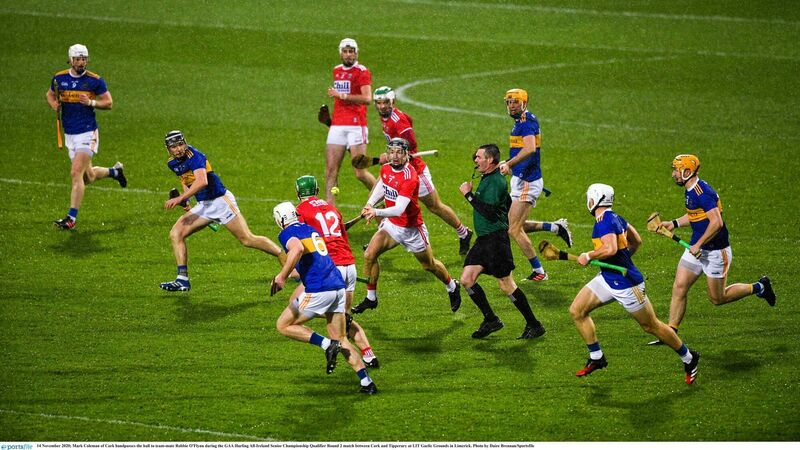Enda McEvoy: Tactics and handpasses - the evolution of hurling

OVERUSED?: Mark Coleman of Cork handpasses the ball to team-mate Robbie O'Flynn. Pic: Daire Brennan/Sportsfile
Eight or nine years ago your correspondent pitched a brilliant idea to a leading Irish publisher. Well, a brilliant but brilliantly unoriginal idea. Well, you know what they say. Good artists copy, great artists steal.
The concept was shamelessly filched from Jonathan Wilson, author of the magisterial . WM formations, magical Magyars, wingless wonders, false nines, all that jazz.
But Wilson also wrote , which was, well, the story of the England team in ten games. The 1953 humiliation by Hungary, the 1966 World Cup final, the endless encounters with Germany and so forth.
So what could have been more obvious a notion than the history of hurling in ten matches? The games that made the game, as it were. Ten that really mattered because of what they represented or the dynasties they birthed. The mileposts.
The chapters positively leaped out.
The 1931 All Ireland final with its three parts, which seized the attention of the nation, brought hurling to a new audience and prompted the to despatch a female writer to Croke Park do a colour piece on the third instalment.
The 1946 final, when Cork beat Kilkenny and Ring went supernova.
That of 1956, when Rackard’s Wexford proved their greatness by beating Cork. And perhaps the Leinster final of the following year which Kilkenny won by playing a new kind of hurling under a new young coach.
Naturally something from the early 1960s as a hat-tip to the greatest Tipp team. Equally naturally the 1966 All Ireland decider and Cork’s return to glory.
Galway and Offaly breaking through in the 1975 National League final and 1980 Leinster final respectively. The 1995 Munster showpiece, of course: the start of Clare, the beginning of Loughnaneism. And Kilkenny’s defeat of Cork in 2006 on an afternoon when two roads diverged in a wood.
All very nice and neat and logical. There was just one problem. The response from Publishing Guy, which was swift, brutal and deflating.
“Great idea,” he said promptly. “But it wouldn’t sell.”
With which, frankly, there was no arguing. Oul’ lads would like the book. Anoraks would adore it. Reviewers would rhapsodise it. About 27 people would buy it.
The publishers had their business model and it worked. Hand over a large wodge to a player or manager, find a willing ghostwriter Instant recognition. Guaranteed sales come Christmas. None of your ethereal concept books here, thank you very much.
All of which is a roundabout way of bringing us to the 2009 All Ireland final. It would have made the cut too.
Not because of the result, or because a four-in-a-row was consummated, but because of the scoreline. Kilkenny 2-22 Tipperary 0-23. Both contestants in an All Ireland final broke the 20-point barrier. Another new frontier.
Only five years beforehand Cork and Kilkenny had mustered 26 points between them. From the promontory of two decades later it sounds risible. And granted, in scoring terms 2004 was an outlier, albeit an encounter perfectly in sync with those awful grim, joyless Leeside/Noreside showdowns – “shootouts” is hardly the mot juste - of the period.
In 2009, however, the protagonists shot the lights out. A Rubicon was crossed and was not for uncrossing.
The two most recent finals have seen the winners break 30 points and the losers break 20 points. That’s still not quite as remarkable as Cork hitting 1-22 two years ago and losing In being turned up to 11 along the way, hurling became bigger, louder, faster. Defenders reinvented as loaders of bullets. Most of the rest of them transformed into rugby centres or wingers, steaming up on the shoulders of a colleague to take the offload.
Check out the 2009 final again. It may have shattered the existing sound barrier but there were no handy scores. The teams absolutely wired into one another from pillar to post. Real adults-only stuff that featured actual defending.
Somewhere else along the way, and not coincidentally, the handpass became corrupted.
With the handpass, less is more. It should be a few drops of peppermint in a glass of whiskey, not an entire bottle of tonic. At the groundbreaking Gormanston coaching course of the 1960s, the Hogwarts of its time, it was championed as a means of linking the play and getting out of tight situations, when a player was surrounded by opponents or the grip couldn’t be shortened.
Done correctly the handpass utilises the skills of that most excellent of native games, liathróid láimhe. It should go without saying that it’s preferable to, and infinitely less unsightly than, the kicked pass. But it was to be used rather than fetishised. A gambit, not the foundation stone of an ethos.
In his 20 seasons as an intercounty referee Barry Kelly encountered the illegal handpass much more frequently, as he puts it, in the breach than the observance. There were far fewer handpasses for one thing. For another, the ones Kelly did patrol were nearly all the result of a clear striking motion.
A fortnight ago Kelly took in two fixtures – Laois v Waterford and Westmeath v Wexford – as a spectator and saw nothing but illegal handpasses. Or to use the technical term, throwing.
While it can be hazardous to be definitive about incidents witnessed on TV as opposed to in the flesh, Conor McDonald’s goal for Wexford in Mullingar came at the end of a move that involved three handpasses. One of them - Liam Óg McGovern’s – entailed an obvious striking motion with the hand. The other two appeared to entail nothing of the sort.
Kelly’s contention that teams are not being coached to handpass the sliotar properly is indisputable. Going on everything we’ve seen over the past couple of seasons it’s no leap to take this further and posit that some are being coached to throw it.
Coaches and players wouldn’t be human if they hadn’t run the percentages. With so many bodies around the ball, will the ref see? Even if he does, can he be sure it’s a throw? Even if he can, how often per game will he blow and risk annoying the crowd? Twice? Three times?
As the former Tipperary full-back Conor O’Donovan, who’s been banging this particular drum since 2008, points out, the rule “is virtually impossible to police due to the sheer number of handpasses per game”.
He reckons three quarters of handpasses these days are throws, a figure that he argues is, if anything, increasing.
“Handpassing is slowing the game down,” O’Donovan adds. “The ball travels faster when struck with the hurley. A player running with the ball – he’s being quick but the game isn’t being quick.”
Now whether hurling, having gone supersonic, needs to get any faster constitutes a moot point, but that’s one for another day. O’Donovan, whose solution is to outlaw the handpass from the hand holding the sliotar, has gone to the trouble of posting a video on YouTube in which he demonstrates three viable alternatives, all of them featuring a clear striking motion, one being to hop the sliotar off the hurley and handpass it with the other hand.
Expect the video to get plenty of hits over the coming weeks. Obviously only the most cynical of folk would suggest that, following the usual fleeting period of the authorities being keen to be seen to get tough, everyone will return to flinging the ball around with impunity come summer.
To finish where we started. Who’s going to pay due homage to Jonathan Wilson and undertake a hurling version of that charts the sport’s tactical evolution?
The line of progression from Tony Wall’s minimalist outlook six decades ago to the hoarding of possession advocated by Davy Fitz and Liam Cahill now. Seventh defenders. Third midfielders. False 11s. Dónal Óg and the way he might puck it out. Those modern speedsters off the shoulder, not to mention that species beloved of the ancients, the full-forward with a roving commission.
It’ll make for cracking reading.
Just one small thing. Who’ll publish it?









